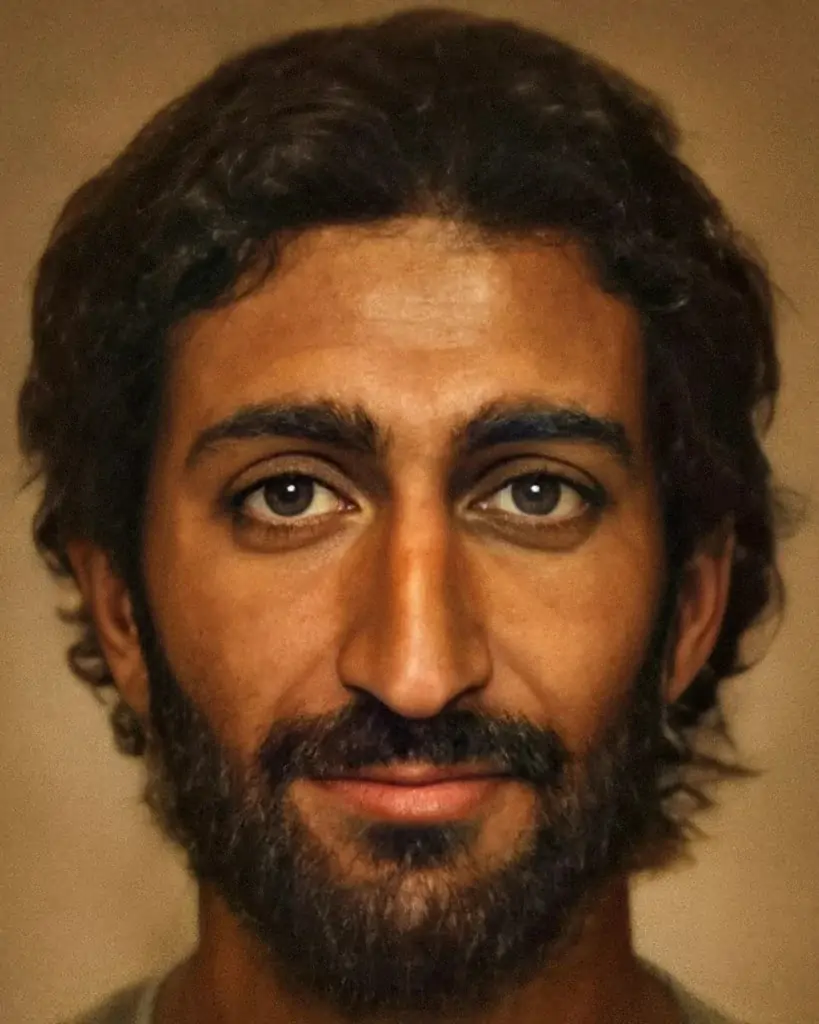After 2,000 years, the true face of Jesus has finally been revealed.
“For Centuries, the Depiction of Jesus Christ Has Been Misguided: A Journey into the Likely Appearance of Jesus”
The image of Jesus Christ, as presented by the Catholic Church, has traditionally been that of a white, European-looking figure with striking blue eyes. However, scholars argue that the real face of Jesus differs significantly from the imaginative depictions by Renaissance painters.
According to these scholars, Jesus, the Son of God, likely resembled an average man from the ancient regions of Palestine: shorter in stature, with a muscular build, and adorned with coiling black hair.
Dutch photographer and digital artist Bas Uterwijk embarked on a quest to uncover the true likeness of Jesus, armed with cutting-edge technology. He sought to create an image of Jesus that aligned closely with the historical context of his birthplace, using Artbreeder’s powerful machine-learning techniques.

Unsurprisingly, the resulting image challenges our common perception of Jesus’ appearance.
Bas explains, “The AI software harnesses the power of a neural network trained on many photographic portraits and painted renditions of human faces.” This ingenious application allows users to blend various facial references to create a synthesized image that considers the user’s aesthetic preferences. Bas used this capability to bring both real and fictional personalities to life.
“My aim was to refine the ethnicity, crafting a Middle-Eastern visage that resonates with authenticity, drawing on a tapestry of artistic portrayals of Jesus of Nazareth rooted in Byzantine and Renaissance traditions, including Leonardo da Vinci’s ‘Salvator Mundi’ and the enigmatic Turin Shroud,” Bas elaborates.
While Bas was satisfied with the result as a representation of the collective cultural depiction, he aimed for greater historical accuracy.
“As a result, I painstakingly adjusted the hair and beard lengths and styles to reflect the norms of that era and region,” he adds. “I incorporated elements from Fayum mummy portraits, pushing Renaissance aesthetics to the margins.”

Bas’ efforts have produced something closer to an artistic interpretation of what Jesus might have looked like rather than a rigorous pursuit of scientific precision.
Born into a Jewish family in Bethlehem in 4 BC, Jesus grew up there before settling in Nazareth, a town in Israel—a story rooted in the Bible. Historical records indicate that the people of Judea and Egypt at that time had olive-toned complexions, ebony-black hair, and brown eyes.
Everyone holds a preconceived image of Jesus’ appearance, perpetuated across civilizations, resulting in universal recognition. However, these iconic features associated with Jesus—flowing hair, robes, and beards—only emerged in the 4th or 5th centuries, according to Joan Taylor, author of “What Did Jesus Look Like.”
In reality, Jesus’ appearance would have differed significantly from these depictions. He would not have had fair skin, and Europe was not his homeland. He was a product of his time, deeply rooted in his geographical and historical surroundings.
Joan Taylor emphasizes, “His complexion would have been darker, complemented by short, raven-black hair—long hair was unusual during the first century. His face would have been adorned with a beard, and his feet would have been clad in sandals.” Jesus lived an itinerant existence with no permanent residence, relying on the generosity of others and sharing in the struggles of the less fortunate.

Historical records support this depiction of Jesus as a humble figure—scruffy, akin to a wanderer with an unkempt appearance, much like a beggar.
As Jesus himself stated, “Foxes have holes, and birds of the air have nests, but the Son of Man has nowhere to lay his head.” This aligns with the most significant aspect of Jesus’ existence.
Remarkably, Jesus’ influence extended beyond his immediate surroundings, reaching people in Europe and Africa. Forensic facial reconstruction specialist Richard Neave was tasked with envisioning the likeness of a first-century Judean man, akin to Jesus.
Neave’s painstaking reconstruction depicts a sturdy man with dusky skin, short hair, and an olive complexion.
As this project sheds light on the layers of Jesus’ likely appearance, we encourage you to SHARE this post with your friends and family on Facebook, sparking meaningful discussions about the historical nuances of the iconic figure we hold dear.



